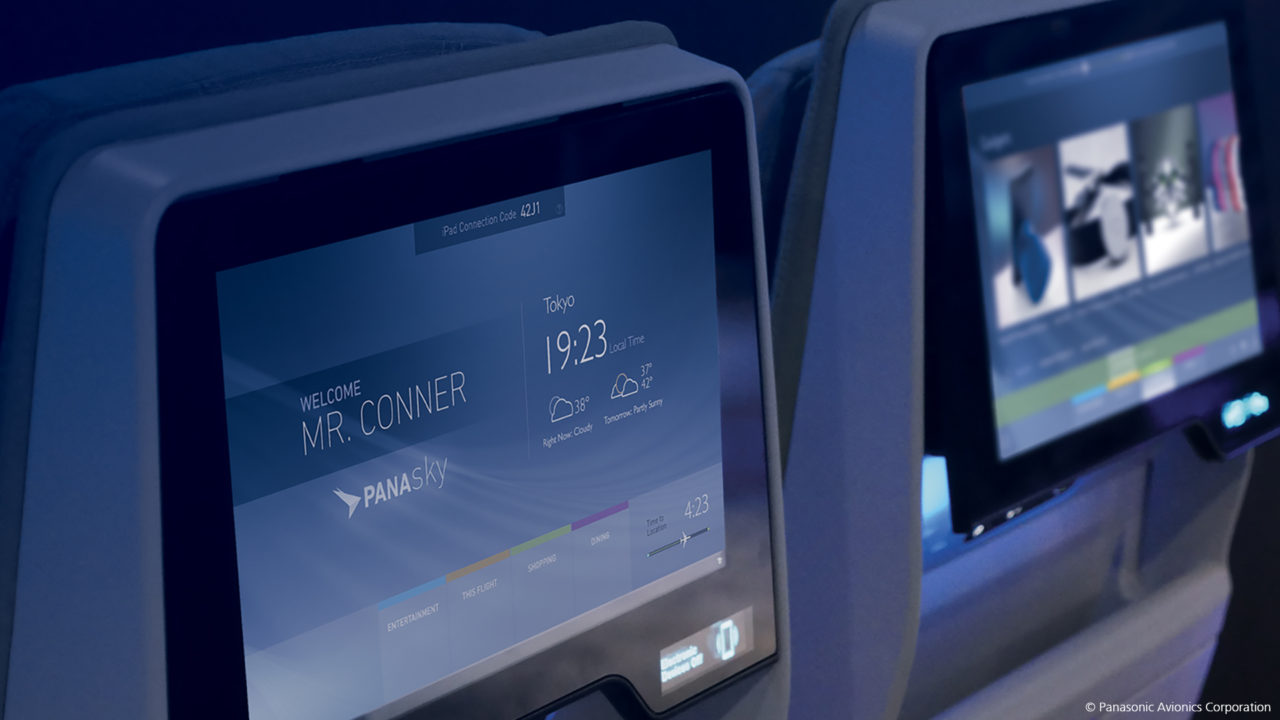Airlines Grapple with New Customer Demands on Connected Aircraft

A Panasonic Avionics seatback display. Photo: Panasonic.
The world of In-Flight Connectivity (IFC) is entering a new era as airlines and suppliers prepare to grapple with new customer demands. David Bartlett, Chief Technical Officer (CTO) of Panasonic Avionics, told the Passenger Experience Conference in Hamburg, Germany this week that the traditional ways of providing content to airlines is changing. “The traditional way with a server on the plane doesn’t scale. So a cloud based solution is the way to go. We can tailor content for every flight. We want to provide a predictive capability. The industry is moving very fast. People’s preferences are moving very fast. The important thing is we have to learn more cohesively as a industry,” he said.
Bartlett said that in the past, suppliers such as Panasonic have tended to deliver a solution that was good for a year or two. He believes the industry will have to do things a lot quicker going forward. “As we go to cloud-based delivery, we will have to be more dynamic,” he said.
Bartlett also highlighted some new areas of interest when it comes to content. eSports, for example, is an area of growing interest to people, and one airlines potentially could take advantage of. With gaming increasingly popular among young people, this could be an area where airlines could differentiate their content.
Scott Ralston, president of product management and in-flight entertainment for Gogo, said the company was looking to power entertainment from a connected perspective. “We would challenge our airlines to think about it a bit differently. Gogo is developing partnerships with companies like T-Mobile, for example. They are cutting deals with MLB, Netflix. We are looking for ways to enable people to have content they own on the ground. We don’t need to outsmart the consumer,” he said.
All agreed that the IFC market is moving very quickly. Craig Foster, senior consultant at Valour Consultancy, highlighted the fact that the entrance of content streaming players has shaken up the market. He also said airlines need to do a better job of making consumers aware these connectivity services exist. “Airlines don’t do a good job of marketing the availability of IFC/IFEC services. They need to advertise the availability. There is a lot could be done to make the payment frictionless. A lot [of messaging] could be done pre-flight.”
Vivian Lo, manager of customer experience and design for Cathay Pacific, said one of the big focuses for the airline was to enable HD content, which she said was in the pipeline for the airline. She added, “The trend is to connect your personal device. The future is enormous for us. Previously, airlines were not able to capture customer data. The current trend is that we can capture accurate customer data and use AI to understand customer behavior. I think it is about relevant content getting to the relevant customer.”
Joon
One of the most interesting case studies presented at the conference this week was a new airline called Joon, a hip, upstart airline owned by Air France. Michael Ruet, the airline’s head of partnerships and advertising, said people were curious how a major airline like Air France can have the mentality of a start-up. Joon has very strong branding around an electric blue color, and wants to be seen as a “laboratory of innovation,” Ruet said. The airline is very bold and wants to create a new generation of travel experience, and is specifically targeting young flyers. It will have 15 aircraft in operation this summer, and by 2020 will be the second largest long haul airline in France. It is also very ecologically focused, looking to use recycled materials where it can.
Celia Geslin, Joon’s product and customer experience manager, said the airline focuses on providing mainly French products as it aims to have a unique identity. Geslin said Joon will has a streaming option for all passengers on board. The airline is working with refurbished A340s, and has put new, more technologically advanced screens on them. Interestingly, passengers will be able to watch Virtual Reality (VR) movies on board for a fee.